![[wcg logo]](../images/wcg.gif)
Home Page
Back to Regional Index
Content and images
© WCG 2003-2015
Click images to enlarge
Last Changed: 26/1/2015
E-mail webmaster


Trip to Ragman Passage & other mines -- 29th June 2013
Group: Hannah, Paul, Mary, DaveThis was a mixed trip to have investigate a shaft to the side of a lime kiln east of Boundary shaft to see if it joined with the workings off Grand Turk and also have a look in the Ragman passage and some nearby sections on the Ragman vein. Dave had done a reccy of the shaft and various other holes in Minera and so we kitted up with SRT gear in the car park and then headed along the track to the the gate and then across to the lime kiln.
The shaft was covered by a loose steel plate and was rigged using a 38m rope from a nearby tree and a scaff bar across the shaft
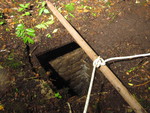
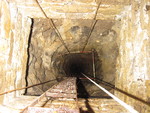
Dave abseiled down first to see if it was a go-er. The ladder at the top was bolted to the metal frame supporting the plate and four steel ropes went down the shaft and supported a scaff frame which the bottom of the ladder was attached. There were a few rungs missing, but it was OK compared to the next wooden ladder which hung from a bit of tat. All the remaining ladders and bits of scaff bar had fallen to the bottom of the shaft together with a tree trunk and this pile of debris blocked the passage which was about 30m deep. Some of the shaft walling had nice flowstone formations.
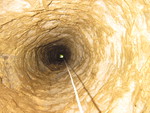
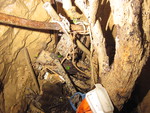
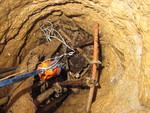
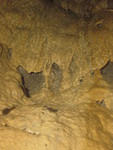
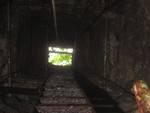
A bit of a disappointment as the ladder-way visible in the mined passage in Grand Turk almost certainly joins up with this shaft. It could be cleared, but it would need a cage at the bottom to protect the workers while stuff is being dragged up the shaft. Actually thinking about it there may be enough scaff at the bottom to make a cage - maybe a winter project...
While Dave de-rigged everyone else headed back to the quarry to escape the midges and we all had lunch in a midge free area. We then headed over towards the Hoffman kiln and entered the low passage leading to the Ragman streamway. A few minutes crawling led to a short drop and the impressive stream passage with very little water flowing.
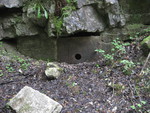
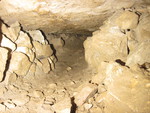
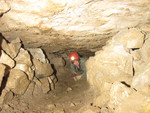
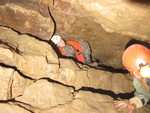

We wadded carefully upstream to the calcite dams for a closer look at the canals and formations. The first section of canal is only just over knee deep, but the next one is waist deep. The formations here are spectacular but very fragile as they have formed over a short period of time due to the nearby lime kiln on the surface feeding calcium rich water into the system. The canals gradually get a very thin surface skin of calcite crystals which get washed away during wet weather.
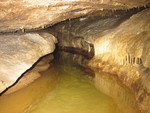
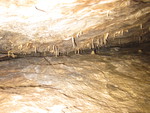
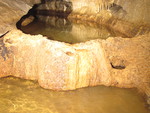
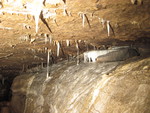
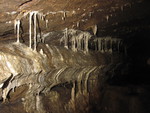
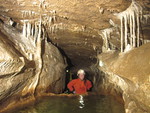
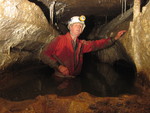
The deeper water proved to be a big problem for the others and so Dave was left to follow the passage to the terminal sump and dive line. There are impressive and delicate mud banks at the side which form a sombre backdrop to the pristine white stalls.
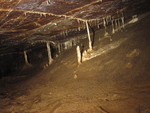
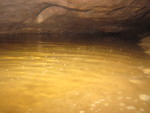
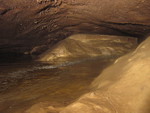
We all headed downstream towards the other sump. The passage was floored with flowstone steps and there are fewer formations as the lime kiln no longer affected the chemistry. There were a few small inlets on the LHS but these were small, fragile and not worth exploring. Eventually the other sump was reached and we turned around and headed back to the pile of boulders and blue pipe marking the way we had come in.
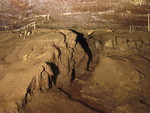
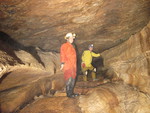
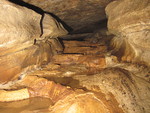
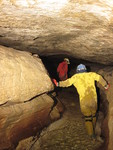
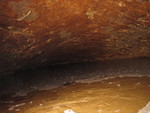
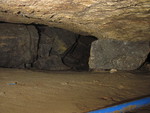
After locking the entrance we headed further around and into a small quarry. When this was blasted out it removed a section of the limestone which contained an earlier mined level on the Ragman vein. This is now in two sections, one on each side of the quarry entrance. The right hand (north west) section was guarded by a steel plate that has seen better days. Heading under this led to a mined passage which was a mixture of crawling and walking over a muddy floor. A few bits of stoping were passed, but after about 100m there was deep water. Since Dave was already wet to the waist he waded in. The passage was low and the water about 3-4' deep and after a while the roof lowered further which made progress slower and wetter. The water contained deep sucky mud which made keeping wellys on quite difficult. After about 50-75m the passage ended at a collapse.
After the disappointment we headed out and had a look in the tiny hole opposite which forms the south east section.
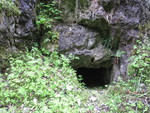
This was at least dry and it led to a passage which just went on for what seemed an eternity. There were some sloping rises into upper stopes and some drops on the right which looked like they joined with a lower parallel passage. We had a good look around, but didn't explore the lower levels or stopes. There was a side passage to the left which ended in a collapse and this could be the spur marked on some plans as going to a whim shaft. Definitely an area which needs a proper explore in the future.
We headed back to the cars and a well deserved pint. Total trip time about 3.5 hours.